|
|
Rybka 3 opening book for Aquarium
The Rybka 3 Aquarium book is Jeroen Noomen's latest work, including new analysis which was done after the Rybka 3 opening book for Chessbase was released. So it comes with fresh ideas and includes all the lines discussed in the examples for the Rybka 3 opening book for Chessbase, too.
Prepared by a leading opening expert
The Rybka Aquarium book was prepared by Jeroen Noomen, who is responsible for Rybka's opening book in her official competitions, including the World Computer Chess Championship which has been won by Rybka for two years running. Jeroen is a leading expert on opening theory, and his imaginative opening innovations have secured Rybka many critical wins. His research methods and analysis tools ensure that his opening books are of great interest to all chessplayers, from the club player to the strongest grandmasters.
High-quality up-to-date games and analysis
The book focuses on the best games of the top GM's (2600 elo or more) in the past two years, as well as the best computer games of the past two years. Additionally, the Rybka Aquarium book is strongly supported by computer checked analysis, and will give you fresh and new ideas that are not published in any openingbook yet and can give you a clear edge in opening preparation compared to chess players that do not have this opening information available.
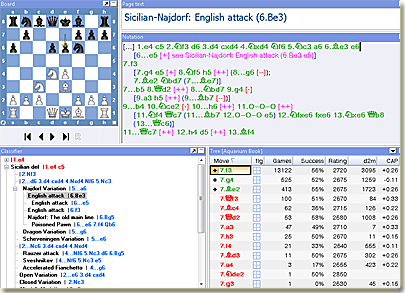
The secrets of human and computer games!
Most opening book authors ignore the vast number of available computer games, although they are high quality games and opening theory is developing rapidly in the computer chess circles. Since computer chess is Jeroen's specialty he is in a unique position to combine the best of both worlds - human chess and computer chess - into a single opening book as he has done with the Rybka Aquarium book. For over the board players, correspondence chess players etc. this means that they will discover lines and analysis that is not available in any other book.
The statistics
The Rybka Aquarium book consists of 11.5 million positions. It's size on disk is 323 MB, which is surprisingly small for a book with this number of positions. If we compare this with a printed opening book containing 1000 positions on each page, you would need 11,500 pages to cover the number of positions in the Rybka Aquarium book.
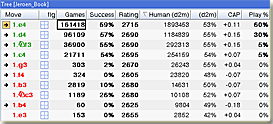
Requirements
You need to install the free update for Aquarium to version 3.1.0 to use the full power of the book, Chess Assistant will be able to use the new book in play with a slight patch. For ChessBase and other software ChessOK plans to release a UCI converter that works between engine and GUI and provides books moves when they are present instead of engine output. With this converter, all UCI-engines would be able to use the book under every GUI.
The i-Book
The Aquarium opening book comes with an i-Book that gives users a more traditional access to the book contents than the tree view alone can do. The i-Book classifier gives you a table of contents for the opening book, so you can quickly locate specific variations.
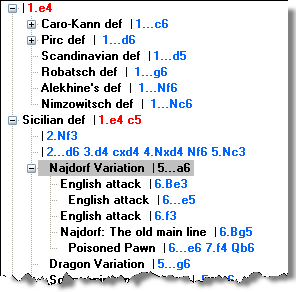
The i-Book classifier for Jeroen's book
In this case the Najdorf variation is selected, which is highlighted in the image (Najdorf Variation | 5...a6). When this is done the notation window is filled with information about the variation as shown in the next image.
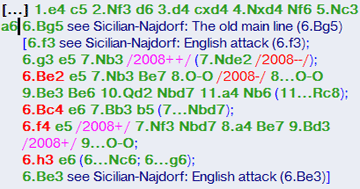
Information is automatically displayed about the selected variation
The cursor is placed after 5...a6, the starting move of the Najdorf variation. The colors of the moves are copied from the opening book:
- The green moves are the ones Jeroen recommends and chess engines using the book would play.
- The red moves would not be played by a chess engine using the book. Note that such moves are not necessarily bad (although they sometimes are). In many cases these are simply variations that Jeroen decided not to emphasize.
- You will also see blue moves in some positions. They lead by transposition to another position in the book.
- Black moves have not been analyzed specifically for the Aquarium book. It doesn't say anything about the quality of the moves. More analysis would be needed to come to a conclusion.
The move colors and other features are describes in greater detail in the document, "The Rybka Aquarium book." You will find it in the Aquarium folder after installation. It is recommended reading for all users.
You will also see text comments in the notation, such as "see Sicilian-Najdorf: English attack (6.f3)." This gives the name of the variation, but also refers to the classifier. You can, for instance, find this particular variation below the one highlighted in the classifier image above.
Finally, there are colored annotations of the type "/2008+/" after some of the moves. These annotations are based on a comparison between the frequency of play in games from 2008 versus statistics from HugeBase. A '++' following the year means that the playing frequency increased by at least fifteeen percentage points in 2008 ('--' stands for corresponding decrease), but for '+'/'-' the limit is ten percentage points.
The Opening Book
The opening book is displayed in the tree window. The installation program for the Aquarium book adds a new tree configuration, "Jeroen_Book" to Aquarium. If you want to view the book, open a game and select the Tree tab in the Ribbon. Then click the leftmost button and select the "Jeroen_Book" configuration from the drop-down list.
Here we see the book information for the starting position of the Najdorf variation.
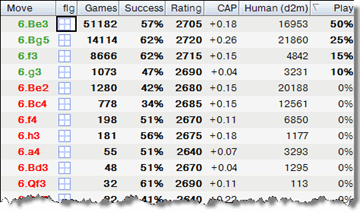
A tree view of the Aquarium opening book
The tree window and the available standard columns are discussed in Dadi Jonssons' ChessOK Cafe columns "Introduction to Tree Configurations" and "Creating Tree Configurations" (see ChessOK Cafe, September and Occotober 2008), so we will just give a brief explanation here with emphasis on columns that have a special meaning in Jeroen's book:
Games. This is the number of games where the indicated move was played in the database that Jeroen used for building the opening book.
Success is the percentage score for the given move in Jeroen's database.
Rating is the average rating of those who played the move in Jeroen's database.
CAP. An update of the CAP analysis tree with the latest evaluations by Rybka 3 is available as a separate download when you buy the Aquarium opening book. You can overwrite your old CAP with the new one. The CAP files are stored in the ATrees directory (cap.*).
Human (d2m). This column shows the number of times a move has been played in games found in HugeBase, which are almost exclusively between human chess players.
Play % gives the percentage distribution that is used for selecting moves when the book is used as an opening book for a chess engine. In the position shown in the image above, 6.Be3 would be played most often or in 50% of the games, followed by 6.Bg5 (25%), 6.f3 (15%) and 6.g3 (10%). Note that these percentages are displayed in bold type in the tree window. It means that they have been manually set by Jeroen. Otherwise the percentages are calculated automatically by Aquarium.
For more details about these and other available book columns, please see "The Aquarium book" document mentioned above.
There is one interesting column, however, which is not mentioned in the document. First you have to download the y2008 tree (see the email you received with your serial number) and extract the zip-file into the ATrees directory. After that start Aquarium, select the "Jeroen_Book" configuration, and while viewing a game, select the Tree tab and click "Options." The "Tree configurations dialog box will be displayed.
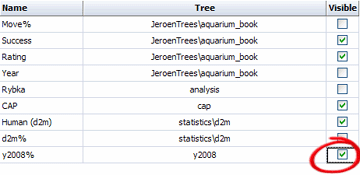
Scroll to the bottom of the list of configuration columns where you will find the "y2008%" column. Select "Visible" to add "y2008%" to the displayed columns and click the OK button. Now the new column will be displayed in the tree window as shown below.
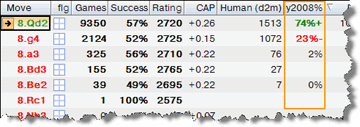
The newly added column, "y2008%" is highlighted. We see that the frequency of the move 8.Qd2 has increased by over ten percentage points in 2008 at the expense of 8.g4, which has declined in popularity.
From the ChessOK Labs
The release of the Aquarium opening book involved many quality checks, both by Jeroen and ChessOK. Such checks may result in new tools for the book authors in the future, while others will remain internal tools, and some will be abandoned in favor of more powerful methods.
One of the methods currently being investigated is comparing book recommendations with analysis available from other sources. In this case, evaluations from the extensive CAP database with Rybka evaluations. The idea is to find positions where those two sources differ in their recommendation (e.g. a move with a high CAP evaluation that is not recommended in the book). Such positions would need to be checked to make sure that nothing is being overlooked. This work is in progress, but some of the results can be found on this web page: Aquarium book vs. CAP evaluations.
We'll examine two results from the comparison between the Aquarium book and the CAP analysis, but first let's take a look at the big picture. The Aquarium book contains 11,5 million positions. Some of those are clearly more important than others, but nevertheless this number shows that it is not possible to check every important position manually. That's why ChessOK is experimenting with automatic methods. The comparison for a particular position can lead to one of three results:
- The difference between the opening book and the CAP evaluations is insignificant.
- There is a significant difference due to inaccuracy in CAP evaluations.
- There is a significant difference and there is an inaccuracy in the book.
Clearly, a huge number of positions will end up in 1), so we don't need to investigate them further. We need to take a closer look at other positions and only then will we know if they belong to 2) or 3). They will be subjected to further analysis and various heuristics until we end up with those positions that could seriously impact the quality of the book. The author of the book can reduce the number even further by eliminating positions that he has already analyzed deeply.
I have two randomly selected examples from the ChessOK analysis. They are only meant to illustrate the type of results that can be expected.
The following position comes from Arizmendi - Grischuk, Reykjavik 2000, after White's ninth move in the King's Gambit.
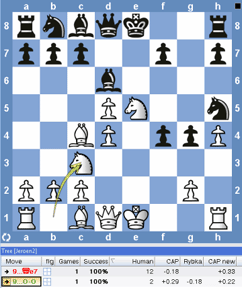
The tree window below the board shows two moves in the Aquarium book, the red move 9...Qe7 and the green move 9...0-0. The CAP analysis included with the Aquarium book, however, recommends 9...Qe7 with an evaluation of -0.18 instead of 9...0-0 with a +0.29 evaluation (see the CAP column). Let's find out what is causing these different move recommendations.
Looking at CAP line we continue 9...Qe7 10.O-O Bxe5 11.Bb5+ Bd7 {-0.48}.
Rybka gives Black the advantage here, although we can see that position looks dangerous for Black in spite of his extra pawn. So we run infinite analysis and continue the forced line 12.dxe5 Qxh4 13.Rxf4 Nxf4 14.Bxf4 and now, after several minutes of analysis, we see that the evaluation changes to White's advantage. Even in this gambit line, we see that Jeroen's move selection is based on careful analysis.
The second example is a position from Van Wely - Carlsen, Nice 2008: 1.d4 Nf6 2.c4 e6 3.Nc3 Bb4 4.Qc2 d5 5.a3 Bxc3+ 6.Qxc3 c5 7.dxc5 d4 8.Qg3 Nc6 9.b4 e5
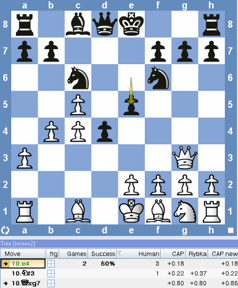
The Aquarium book recommends 10.e4 as was played in the game, but comparison with CAP reveals the new move 10.Qg7!. So in rare cases you can find improvements on book moves using the CAP values, mainly in side lines where not many games were played.
Interview with Jeroen on the Rybka 3 Aquarium opening book
Examples from the Rybka 3 Aquarium opening book
Get the Rybka 3 Aquarium opening book
Rybka 3 opening book for Chessbase
The Rybka 3 opening book for Chessbasehas been developed in a period of 6.5 months. Using very fast computers to verify move selection and to come up with new continuations, the book provides you with profound coverage on the topical main lines of today. In this information centre I'll give some additional information about the book and show you some typical and new ideas. Furthermore a few positions from the book are shown with a surprising tactical blow or a creepy move.
What can you expect from the Rybka 3 opening book?
The Rybka 3 opening book for Chessbase:
1.Is based on the best GM and computer games of the past few years.
2.Covers topical and popular lines in depth.
3.Provides you with fresh new ideas, novelties and original analysis you cannot find elsewhere.
4.Provides you with a repertoire based on modern theory, but also doesn't forget about older and less popular lines.
5.Is thoroughly computer checked with Rybka running on fast hardware (Quad and Octal core).
6.Has been tested in about 8,000 test games.
A special mention: the Sicilian Najdorf
The ever popular Sicilian Najdorf was the weapon of some of the best players in the past and is still in the spotlight in 2008. The Rybka 3 opening book covers all the Najdorf lines in depth and you can expect some very interesting new lines and fresh ideas. Especially the sharp 6.Bg5 and 6.Be3 lines are given much attention and you'll find out that the Najdorf is not only 'alive and kicking', but is experiencing a new life with the help of fast computers and Rybka.
For whom is the Rybka 3 opening book interesting?
Although the Rybka 3 book is especially designed for the Rybka 3 engine, it might also be used as a theoretical guide on topical lines by:
- Correspondence chess players
- Tournament chess players
- All other chess players interested in the latest theory on the most popular opening lines of today
- ChessBase users
- Chess enthousiasts interested in playing engine-engine games
- Fritz, Junior, Hiarcs or other ChessBase engine users, who want to update their opening books
Please note that the Rybka 3 book is a database only and hence doesn't explain moves and has no texts!
To use the Rybka 3 book you need an interface that is able to open .ctg books (i.e. Chessbase/Fritz or Aquarium).
Examples
The next sections will give you some examples of the Rybka 3 opening book: some topical lines, novelties and fresh ideas are shown. Also I give you 10 wild positions from the book containing a surprising tactical stroke or creepy move. Enjoy:
A stunning novelty in the Petroff
IM Merijn van Delft showed me a fantastic new idea in the Petroff (which already has been played a few times in practice): 1.e4 e5 2.Nf3 Nf6 3.Nxe5 d6 4.Nf3 Nxe4 5.Nc3 Nxc3 6.dxc3 Be7 7.Bf4 Nc6 8.Qd2 Be6 9.O-O-O
9... Bxa2!
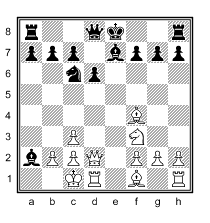
Now black loses a piece after 10.b3 a5 11.Kb2, but of course that is not the end of the story. After the unfortunate bishop on a2 has been captured, black obtains dangerous counterplay leading to very interesting 'non Petroff like' positions.
Poisoned Pawn: 10.e5 not dangerous after all
In 2007 the Poisoned Pawn variation of the Sicilian Najdorf was experiencing a crisis due to 1.e4 c5 2.Nf3 d6 3.d4 cxd4 4.Nxd4 Nf6 5.Nc3 a6 6.Bg5 e6 7.f4 Qb6 8.Qd2 Qxb2 9.Rb1 Qa3 10.e5!? The Rybka 3 book shows you a fairly easy solution to black's problems: 10... h6 11.Bh4 dxe5 12.fxe5
and now instead of the usual 12... Nfd7: 12... Nd5!
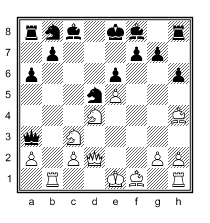
Computer programs on very fast hardware have failed to show even an edge for white after this surprising continuation.
English attack: taking the sting out of 23.Rh3
In one of the most complicated lines in the English attack of the Sicilian Najdorf black faced some real problems recently. After 1.e4 c5 2.Nf3 d6 3.d4 cxd4 4.Nxd4 Nf6 5.Nc3 a6 6.Be3 e5 7.Nb3 Be6 8.f3 Be7 9.Qd2 O-O 10.O-O-O Nbd7 11.g4 b5 12.g5 b4 13.Ne2 Ne8 14.f4 a5 15.f5 a4 16.Nbd4 exd4 17.Nxd4 b3 18.Kb1 bxc2+ 19.Nxc2 Bb3 20.axb3 axb3 21.Na3 Ne5 22.h4 Ra4 23.Rh3!? seemed to spoil all the fun for black. The Rybka 3 book takes the sting out of this dangerous move: 23... Qa8 24.Qd5
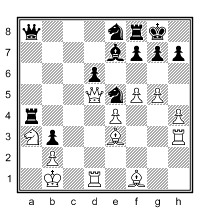
24... Rxa3! and white has to be satisfied with equality. Also check out the very interesting alternatives 23.Bd4!? and 23.Qc3!?, which are both deeply covered in the Rybka 3 book.
A revival of the sharp Botwinnik
After the move order 1.d4 d5 2.c4 c6 3.Nf3 Nf6 4.Nc3 e6 5.Bg5 dxc4 6.e4 b5 7.e5 h6 8.Bh4 g5 9.Nxg5 hxg5 10.Bxg5 Nbd7 11.exf6 Bb7 12.g3 c5 13.d5 Nxf6 14.Bg2 in the sharp Botwinnik Semi Slav, black has an easy equaliser at his disposal:
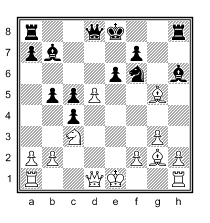
14... Bh6! Current computer analysis shows that black has no problems to keep the balance.
English attack: an amazing rook sacrifice
2007 saw an amazing new idea in one of the most topical English attack lines of the Najdorf: 1.e4 c5 2.Nf3 d6 3.d4 cxd4 4.Nxd4 Nf6 5.Nc3 a6 6.Be3 e5 7.Nb3 Be6 8.f3 Be7 9.Qd2 O-O 10.O-O-O Nbd7 11.g4 b5 12.g5 b4 13.Ne2 Ne8 14.f4 a5 15.f5 Bxb3!? 16.cxb3 a4 17.bxa4 Rxa4 18.Kb1
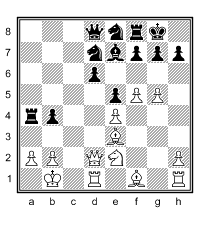
And now: 18... Rxa2!
To take or not to take, that is the question.... Should white decline the rook sacrifice with 19.Nc1, or can he try 19.Kxa2 Qa8+ 20.Kb3? The Rybka 3 book will tell you all the secrets of this fascinating line.
Sicilian Sveshnikov: black close to equality?
The positional variation is still the most popular try against the Sicilian Sveshnikov: 1.e4 c5 2.Nf3 Nc6 3.d4 cxd4 4.Nxd4 Nf6 5.Nc3 e5 6.Ndb5 d6 7.Bg5 a6 8.Na3 b5 9.Nd5 Be7 10.Bxf6 Bxf6 11.c3. I think we might see a lot more of 11... Bg5 12.Nc2 Rb8!? 13.a4 bxa4, as the theoretical 14.Ncb4 Nxb4 15.cxb4 Bd7 16.Bxa6 O-O 17.O-O Bc6 18.Rxa4 leads nowhere, as has been confirmed in several Freestyle encounters. The Rybka 3 book comes up with a relatively new idea, also played in the latest Freestyle event: 14.Nce3!?
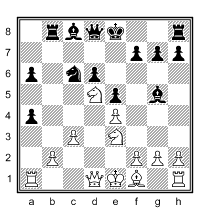
This sets new problems for black and is therefore an interesting alternative to the logical 14.Ncb4.
Another sharp line in the popular Slav
In the Slav defence the pawn sacrifice 1.d4 d5 2.c4 c6 3.Nc3 e6 4.e4!? dxe4 5.Nxe4 Bb4+ 6.Bd2 Qxd4 7.Bxb4 Qxe4+ 8.Be2 has been very popular lately. Black used to be in good shape, but white players have found new ideas which makes the line attractive and dangerous at the same time.
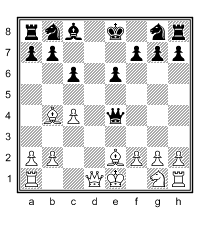
Check out the Rybka 3 book for more ideas and original computer analysis on this topical line. And find out black's life might not be that easy....
Ruy Lopez Zaitsev: the agressive 12.a4
In the Ruy Lopez Zaitsev white's most agressive try is undoubtedly 1.e4 e5 2.Nf3 Nc6 3.Bb5 a6 4.Ba4 Nf6 5.O-O Be7 6.Re1 b5 7.Bb3 d6 8.c3 O-O 9.h3 Bb7 10.d4 Re8 11.Nbd2 Bf8 12.a4!? Play usually develops 12... h6 13.Bc2 exd4 14.cxd4 Nb4 15.Bb1 c5 16.d5 Nd7 17.Ra3 c4, leading to the position in the diagram:
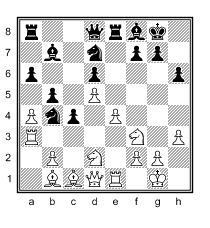
Find out about new white ideas in the main line 18.Nd4, as well as the interesting sideline 18.Ree3!? Food for agressive and attacking players!
The popular and complicated Moscow gambit
Currently the Moscow gambit is one of white's most popular tries to combat the black Semi Slav. After 1.d4 d5 2.c4 c6 3.Nf3 Nf6 4.Nc3 e6 5.Bg5 h6 white sacrifices a pawn by 6.Bh4 dxc4 7.e4 g5 8.Bg3 b5:
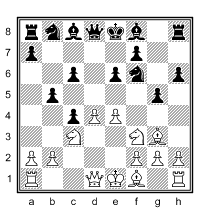
Check what GM's and Rybka 3 have to say about this complicated and highly topical line.
Perenyi attack: dangerous, or just a draw?
Another razor sharp and very dangerous line against the English attack with 6... e6 is the Perenyi attack: 1.e4 c5 2.Nf3 d6 3.d4 cxd4 4.Nxd4 Nf6 5.Nc3 a6 6.Be3 e6 7.g4!? After 7... e5 8.Nf5 white is prepared to sacrifice a piece for a lot of pressure:
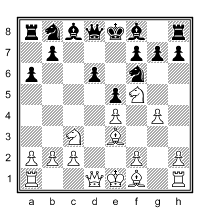
Is this line really dangerous for black, or is it just a forced draw after 8... g6? And what about the surprising 8... h5!? In depth analysis in the Rybka 3 book will tell you all about it.
A new main line in the English attack
In the English attack 1.e4 c5 2.Nf3 d6 3.d4 cxd4 4.Nxd4 Nf6 5.Nc3 a6 6.Be3, the move 6... e6 is maybe slightly less popular than 6... e5, but it deserves full attention as well. In my opinion this is going to be the main line: 7.f3 b5 8.Qd2 Nbd7 9.g4 b4 10.Na4 (also very sharp and interesting is 10.Nce2!?) 10... h6! 11.O-O-O Ne5 12.Qxb4 Bd7 13.Bf4! g5 14.Bd2:
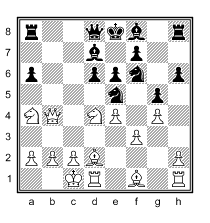
Now surprisingly 14... Rb8 - although very natural - seems to be the worse choice for black. Incredible deep computer analysis shows that white is better after this move. So best in the diagram is 14... Be7! which seems to be the equalizer.
Some spectacular moves from the Rybka 3 book
In the process of making the Rybka 3 book I hit on many beautiful variation and spectacular blow. In this section I want to present a few of these amazing tactical shots and 'creepy moves'. You will find them all in the new book. Enjoy:
Position 1: Sicilian Rauzer
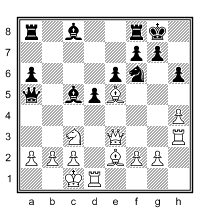
17.Qxh6!! winning
Position 2: Ruy Lopez Zaitsev
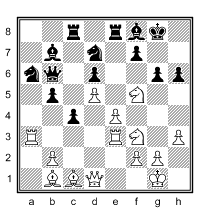
23.N3h4! b4 24.Rg3! Ne5 25.Rxg6+!! winning
Position 3: Sicilian Najdorf
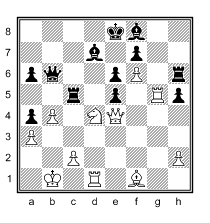
White plays 25.Bb5!!
Position 4: Sicilian Najdorf
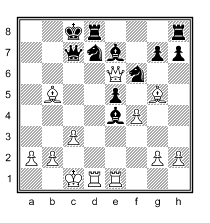
Black plays 17... Ba3!
Position 5: Sicilian Najdorf
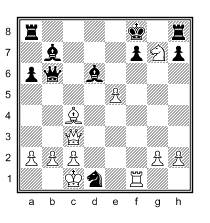
Black plays 20... Bd5!!
Position 6: Sicilian Najdorf
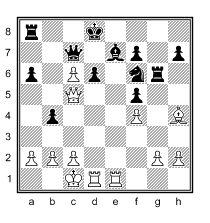
White plays 21.g4!
Position 7: Poisoned Pawn
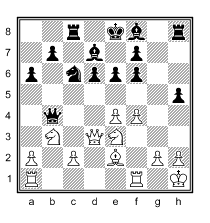
Black to move: 16... Ne5!
Position 8: Poisoned Pawn
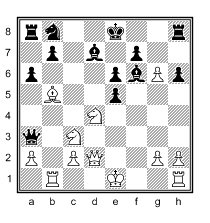
White to move: 16.O-O!!
Position 9: Poisoned Pawn
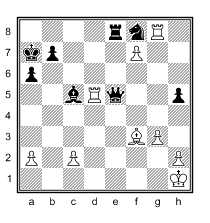
White to move: 36.Kg2!!
Position 10: Poisoned Pawn
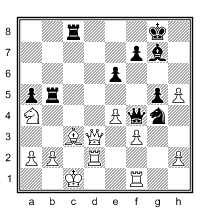
Black to move: 29... Rxb2!!
Credits
This opening book would never have been possible without the help of:
Vasik Rajlich's & Larry Kaufman's great new Rybka 3 engine, she found many novelties and was a huge help in analysing a lot of interesting positions and new ideas.
Dagh Nielsen, who gave me a fresh new insight in analysing opening lines and with whom I had many inspiring analysis sessions. Dagh's work in the Najdorf is absolutely amazing!
Iweta Rajlich, who kindly provided me with excellent analysis in some opening lines.
Merijn van Delft, for showing me this spectacular Petroff novelty and making it a joint effort to analyse it for the Rybka 3 book.
Lukas Cimiotti, for letting me use his fabulous hardware, this 8 Core Skulltrail machine rocks!
The Playchess engine room, what you guys do is amazing and without you this opening book would never exist!
My Q6600 Quad Core PC, as good analysis is simply impossible without good hardware.
ChessBase, for their enthousiasm & support and giving me this great opportunity.
Buying the new Rybka 3 book
The Rybka 3 book is available through ChessBase, or any other shop selling ChessBase products. More information can be found here:
Chessbase shop
Chessbase shop (German)
August 2008,
Jeroen Noomen (Rybka book author)
|
|
|
